1. Introduction-Biodiversity
Diversity in Living Organisms
Introduction
- We all know that there are abundant of living organisms present on the earth. Many organisms are not identical to each other.
- This variety of living beings present on the earth is called as a Biodiversity.
- Here is a separate branch of Biology called Taxonomy which identifies, names and classifies different organisms present on the earth.
- Carolus Linnaeus is known as the Father of the Modern Taxonomy.
- Binomial nomenclature is the naming of organisms with two names- genus and species.
- It was first established by Carl Linnaeus and later adopted by all scientists for the universal naming of organisms.
- The Law of priority is established if the same name is shared by two different species or two different taxa.
- Taxonomy deals with the identification, nomenclature, and classification of organisms.
2. Classification System
Classification of Living Things
• Classification presented by Aristotle – He classified animals on the basis of their habitats – land, water and air.
• But it can be easily observed that the animals that live at a particular habitat say land are still so different from each other.
• Therefore, it was decided to classify the living organisms on the basis of a hierarchy.
• This hierarchical classification was based on the similarities and dissimilarities in the characteristics of the living organisms.
• Organisms having similar characteristics were placed in a similar category.
Why do we need to classify organisms?
1. If we classify organisms into several categories, it will be easier for us to study them.
2. It will help us in understanding how did these organisms evolve.
3. We can also understand how different organisms are related to each other.
4. We can learn why different organisms are found at distinct geographical conditions.
Hierarchy Classification - Formation of Kingdoms
Biologists categorized different organisms into several kingdoms.
|
Classification |
Proposed by |
Type of organisms |
|
|
Two kingdom classification |
Carolus Linnaeus in 1758 |
1. Plants |
|
|
2. Animals |
|||
|
Five Kingdom classification |
Robert Whittaker in 1959 |
1. Monera |
|
|
2. Protista |
|||
|
3. Fungi |
|||
|
4. Plantae |
|||
|
5. Animalia |
|||
|
Carl Woese in 1977 |
1. Monera |
||
|
(i) Archaea |
|||
|
(ii) Eubacteria |
|||
|
2. Protista |
|||
|
3. Fungi |
|||
|
4. Plantae |
|||
|
5. Animalia |
|||
|
|
|
|
|
The order of Classification
1. Kingdom
2. Phylum / Division
3. Class
4. Order
5. Family
6. Genus
7. Species
Species is called as the Basic Unit of Classification. Species is a group of organism which can interbreed with each other. The picture below explains how humans are classified in a hierarchical order.
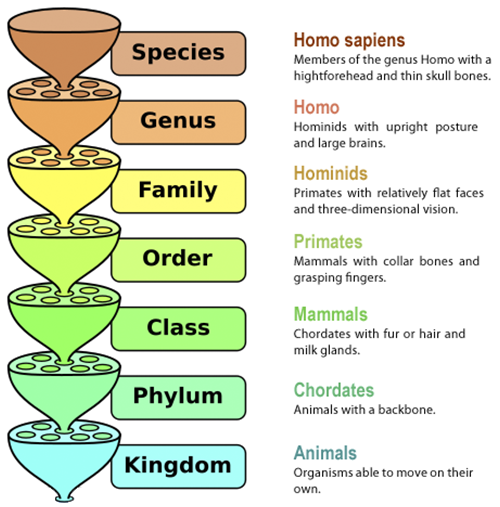
Hierarchical Order of Classifying Humans
Five Kingdom Classifications
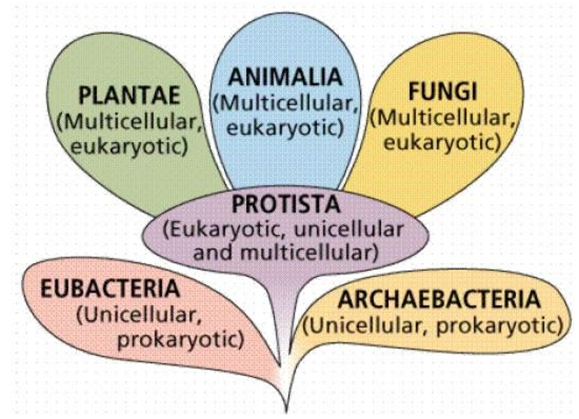
Five Kingdom Classification
- The organization inside the cells
-
- Prokaryotic Cells – Cells with no definite nucleus
- Eukaryotic Cells – Cells with a definite nucleus
- The organization of cells in the body
-
- Unicellular – Single-celled organisms
- Multicellular – Multi-cell organisms
- organisms obtain their food
-
- Autotrophs – Produce their food on their own
- Heterotrophs – Depend on other organisms for their food
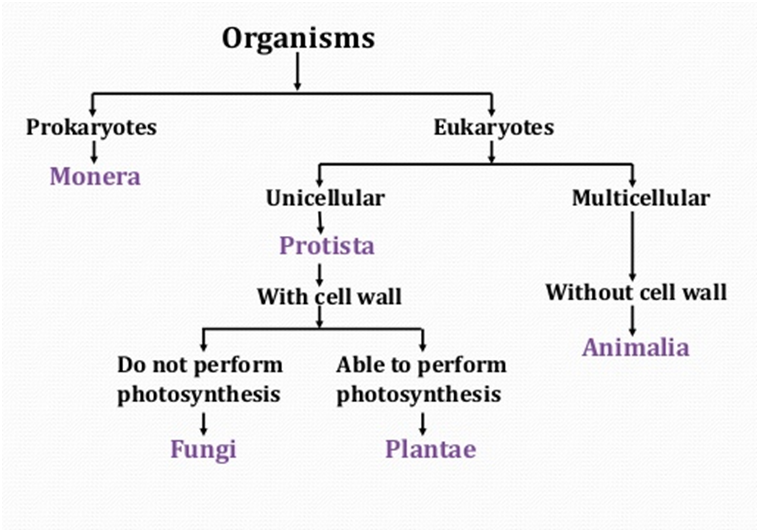
Classification of Organisms
Classification of Organisms
|
|
Monera |
Protista |
Fungi |
Plantae |
Animalia |
|
Organization inside the cells |
Consists of Prokaryotes. |
Eukaryotes – some of them use appendages to move around such as flagella (whip-like structure) and Cilia (hair-like structure) |
Eukaryotes |
Eukaryotes |
Eukaryotes |
|
Organization of cells in the body |
Unicellular |
Unicellular |
Initially unicellular. Can become multicellular in later stages of life |
Multicellular |
Multicellular |
|
Organisms obtain their food |
Some of them are autotrophs like blue green algae while others are heterotrophs |
Both autotrophs and heterotrophs |
Heterotrophs. Most of them are decomposers or may be parasitic. |
Autotrophs |
Heterotrophs |
|
Presence of cell wall |
Some lack a cell wall while others have a cell wall |
Only some have cell wall |
Have cell walls. They are made up of complex sugar called chitin. |
Have cell walls made of cellulose. |
No cell walls |
|
Example |
Blue-green algae, Bacteria, Mycoplasma |
Protozoan, Diatoms and Golden algae |
Yeast and Mushroom ( Agaricus), Rhizopus ( Bread mould), Pencillium |
Flowering plants, moss |
Insects, reptiles |
Archea Kingdom
The monera kingdom is further classified as Archaea.
These are microbes (bacteria) that can live in harsh conditions. Since they can live in extreme temperatures, they are also called Extremophiles.
These organisms lack a cell wall.
Their cell membrane is made up of lipids.
They are further classified into three categories, based on their habitat:
|
Halophiles |
Thermophiles |
Methanogens |
|
These are salt loving bacteria. They live in extremely salty water. |
They live in boiling water such as hot springs and volcanoes. |
They are found in the guts of animals like cow and sheep. They produce methane gas from their dung. |
Who are Saprophytes?
Fungi also called as Saprophytes because they grow over the organic material and survive on them.
What are Symbiotic relationships?
Some species of fungi live in permanent mutually dependent relations with blue-green algae. They are said to have a symbiotic relationship. For Example, Lichens are often found on the bark of the trees.
3. Plant Kingdom
Kingdom Plantae
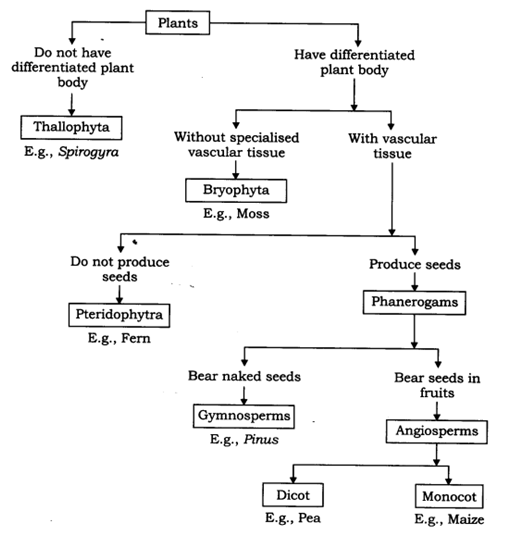
Plant Kingdom
• Components of Plants – whether they are distinct or not
• Presence of Special Tissues in plants for the transportation of food and water
• Presence of Seeds – whether the seeds are present inside the fruits or not.
Classification of plants on the ability to produce seeds -
• Cryptogams – These plants do not have well developed reproductive organs. The organs cannot be seen clearly as well and appear as if they are hidden. Example are Thallophyte, Bryophyta and Pteridophyte.
• Phanerogams – These plants have well developed reproductive organs hence they can produce seeds. They are further classified as the ones which have seeds hidden inside fruits or not - Gymnosperms and Angiosperms
|
Criteria |
Thallophyta |
Bryophyta |
Pteridophyta |
|
Components of plants |
No distinct components. Undifferentiated Body |
Little differentiated body. Distinct components are present as leaves and stem |
Distinct components are present as roots, leaves and stem |
|
Presence of special tissues- Vascular tissue |
No |
No |
Yes |
|
Presence of seeds |
No |
No |
No |
|
Found in |
Aquatic environment, snow |
First terrestrial plants but but need water for sexual reproduction. So called as Amphibian of plant kingdom. |
Terrestrial or dry areas |
|
Example |
Spirogyra, Ulothrix, Volvox |
Moss and liverworts |
Ferns |
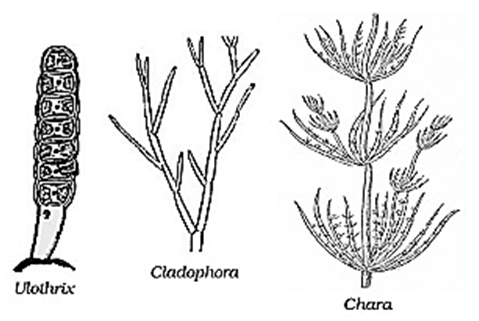
|
|
Gymnosperms |
Angiosperms |
|
The ability to produce seeds |
Naked seeds |
Seeds develop in an organ which then turns into the fruit |
|
Existence |
Exist for long time periods, Evergreen |
Grow for varied time periods |
|
Type |
Woody, No flowers |
Flowering plants |
|
Meaning |
Gymno – naked |
Angio – Covered |
|
Sperm – seeds |
Sperma – seeds |
|
|
Example |
Pines, Deodar |
Mustard, Maize |
What are Cotyledons?
The seed leaves in Angiosperms are called Cotyledons. They turn green on the germination of the seeds. Angiosperms can be divided into two types on the basis of the presence of cotyledons in them-
- Monocotyledons or monocots
- Dicotyledons or Dicots
|
Criteria |
Monocotyledons or Monocots |
Dicotyledons or Dicots |
|
Cotyledons (Seed Leaves) |
Single Cotyledon |
Two Cotyledons |
|
Leaves |
Long leaves, with parallel veins |
Broad leaves with network of veins |
|
Roots |
Fibrous |
Long taproot |
|
Floral Parts |
Multiples of three |
Multiples of four or five |
|
Example |
Corn, Wheat, Grass |
Rose, Sunflower, Lily |
4. Animal Kingdom
Kingdom Animalia
Basic Characteristics of the Animalia Kingdom
1. Animals are eukaryotic, multicellular organisms that lack a cell wall.
2. They are heterotrophs therefore they rely on others for food.
3. They have a growth pattern. The adult animals have a specific shape and size.
4. Most of the organisms have well-defined organ systems such as Respiratory System, Digestion System and so on.
5. Most of the animals can move. They aren’t stationary as Plants.
6. Animals have a nervous system which is why they are able to respond to an external stimulus.
Animals are classified on the basis of differences in their body type and design. The body cavity or coelom in animals contains the organs. Based on the presence of body cavity animals can be categorized as:
1. Coelomate – They have true body cavity called Coelom
2. Pseudocoelomate – It means false cavity. They have a body cavity which is filled with fluid
3. Acoelomate – They have no body cavity at all.
1. Phylum - Porifera
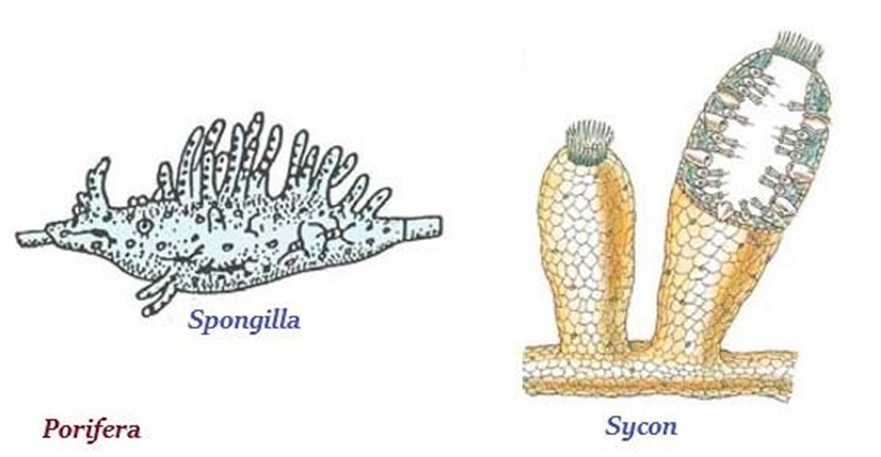
Phylum- Porifera
• Level of Organization – Cells are present
• Symmetry – Asymmetrical
• Segmentation – No segments
• Body Cavity/ Coelom – No
• Presence of Organs – No
• Examples – Sycon, Spongilla, Euspongia
• Other Characteristics-
o They cannot move and are attached to a support.
o They have pores in their body
o These pores form a Canal system through which water and food circulate in the body and waste is removed.
o They have a skeleton made of spongin protein and calcium carbonate – hard covering on them
2.Phylum - Coelentrata
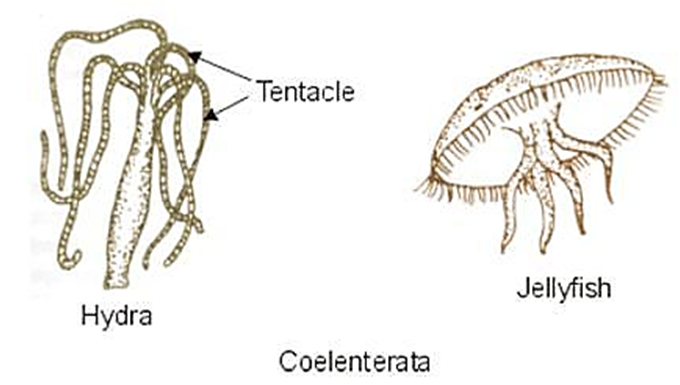
Phylum- Coelenterata
• Level of Organization – Tissues, Cells have two layers – so called as Diploblastic Organism
• Symmetry – Radial
• Segmentation – No segments
• Body Cavity/ Coelom – No
• Presence of Organs – No
• Examples – Aurelia (Jelly fish) and Adamsia (Sea Anemone)
• Other Characteristics –
o Some of them live in colonies - They are physically attached to each other such as Corals
o Some of them live solitary such as Hydra
3.Phylum - Platyhelminthes
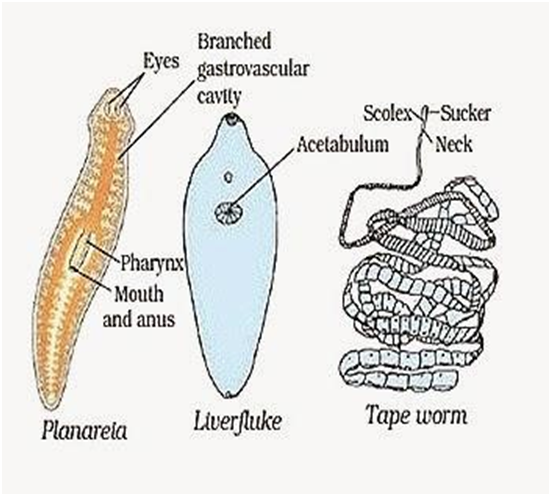
Phylum Platyhelminthes
• Level of Organization – Organs, The cells have three layers – so are called Triploblastic
• Symmetry – Bilaterally Symmetrical - Left half of the body is identical to the right half
• Segmentation – No segments
• Body Cavity/ Coelom – No so called as Acoelomates
• Presence of Organs – Yes
• Examples – Taenia solium (Tapeworm), Fasciola hepatica (Liver Fluke)
• Other Characteristics -
o They have a flat body and thus are called Flatworms
o They can be Free-living like Planaria or parasitic.
4. Phylum- Nematode
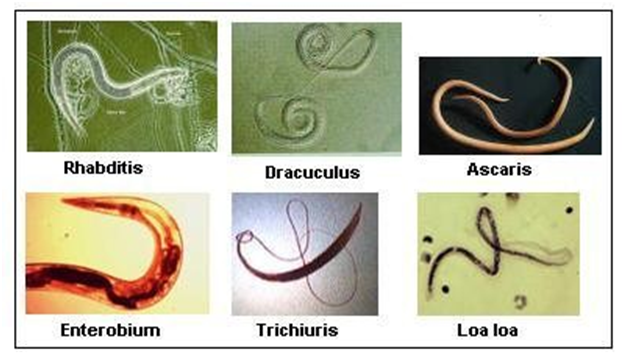
Phylum Nematoda
• Level of Organization – Tissues so are called Triploblastic
• Symmetry – Bilaterally Symmetrical - Left half of the body is identical to the right half
• Segmentation – No segments
• Body Cavity/ Coelom - False body cavity so called as Pseudocoelomates
• Presence of Organs – Organ System Level Organisation
• Examples – Parasitic worms and worms in the intestine
• Other Characteristics–
o They are called as Round Worms.
o Sexual dimorphism visible - Female and male worms are distinct.
- 5. Phylum Annelida
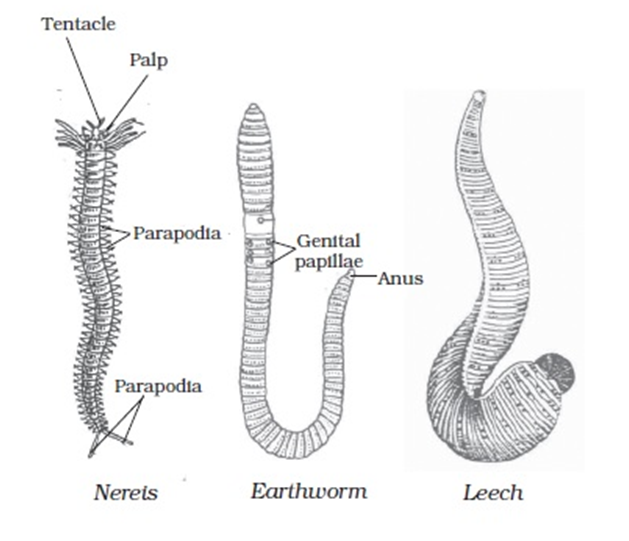
Phylum Annelida
• Level of Organization – Organ system level, the cells have three layers so called Triploblastic
• Symmetry – Bilaterally Symmetrical
• True Segmentation – Present (organs can be identified separately)
• Body Cavity/ Coelom – True body cavity so called as Coelomates
• Presence of Organs – Definite organs
• Examples – Leech, Earthworms
• Other Characteristics –
o They are found in freshwater and marine water.
o They have closed Circulatory system.
6. Phylum Arthropoda

Phylum Arthropoda
• Level of Organization – Organ systems
• Symmetry – Bilaterally symmetrical
• Segmentation – Present (organs can be identified separately)
• Body Cavity/ Coelom – True body cavity
• Presence of Organs – Definite organs
• Examples – Prawns and butterflies
• Other Characteristics
o They have jointed legs
o They have an open circulatory system – There are no well-defined blood vessels
o They have chitinous exoskeleton
7. Phylum - Mollusca
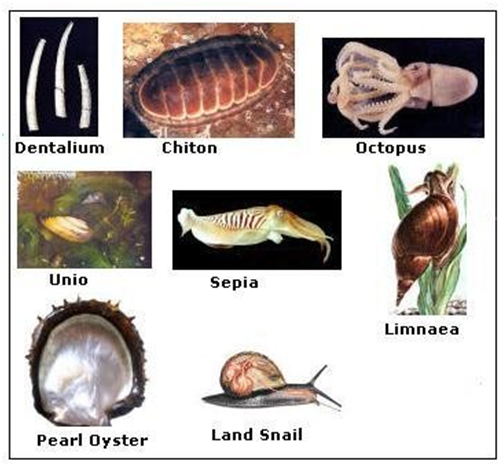
Phylum Mollusca
• Level of Organization – Organ systems, the cells have three layers– called Triploblastic
• Symmetry – Bilaterally symmetrical
• Segmentation – Little segmentation
• Body Cavity/ Coelom – Reduced
• Presence of Organs – Definite organs
• Examples – Snails
• Other Characteristics
o Body is divided into head, Visceral Mass and Muscular Foot.
o Some of the molluscs have hard external shell like that of Snails and some have internal reduced shell like that in Octopus.
o They have an open circulatory system
o There is a kidney-like organ for excretion

 Science Made Easy
Science Made Easy
